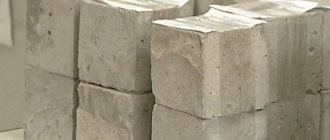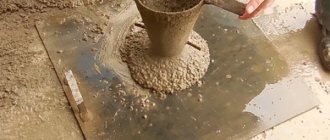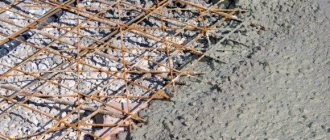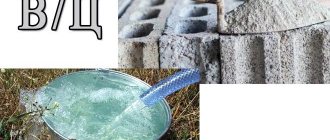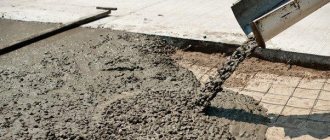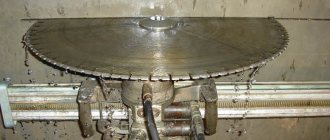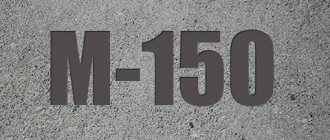- 1 What is the mobility of mixed concrete?
- 2 Types of mobility
- 3 What does it depend on?
- 4 How is it designated?
- 5 How to determine mobility?
- 6 Table of mobility of concrete mixture
- 7 Mobility and composition of the mixture
- 8 Conclusion
The construction industry has demanded building materials with various characteristics. These include concretes with a wide variety of properties and quality indicators. Accordingly, when carrying out work, it is necessary to quickly obtain an accurate assessment of the properties of a given material, for example, the fluidity of concrete, which directly affects its performance characteristics along with strength.
Types of mobility
Technological convenience of using a concrete mixture - the mobility of concrete has an established classification of degrees of fluidity. The more fluid the concrete, the better it fills voluminous and dense reinforcement in formworks of complex configurations. Solutions are divided into low-mobile and highly mobile. The former are not used without vibrocompression and the addition of plasticizers. Compositions that contain fewer of the mentioned components are considered sedentary.
Return to contents
Determining factors
Workability can be influenced in a variety of ways. Also influenced by environmental conditions. Let's consider each factor influencing the mobility of concrete. Here's what it is:
- Cement content .
The binder component, when mixed with water, forms relatively weak bonds before hardening and spreads easily. Solid fillers create additional resistance, which reduces mobility.
- Water volume .
The consistency of the working mixture depends on this ingredient. If you maintain the proportions of the remaining components, but add more water, the fluidity of the solution will increase. True, this approach negatively affects the final strength of the monolith.
High fluidity solution Source prok-plus.ru
What does it depend on?
The mobility of concrete depends on the components, their quality and quantity.
The mobility of the concrete mixture is determined by the grade of cement, the density of the cement paste, the water-cement content, the fraction and grain shape of the fillers (sand and crushed stone), the purity of the fillers (water, sand and crushed stone), the ratio of the components (sand, cement, water, lime, crushed stone) , quality and quantity of additives. It also depends on the conditions of pouring into formwork at the site.
A dense and voluminous reinforcement frame will require increased fluidity of concrete mixtures, since vibratory compaction is difficult in such conditions. When a low-moving composition is used in such conditions, the density after compaction may not meet the established standards (pores, cavities). Therefore, when selecting a concrete composition based on the degree of mobility (rigidity and cohesion), you should know the requirements for the supporting structure of the structure (especially important for the foundation) and the specific conditions for its pouring (the complexity of the formwork shape and the density of the reinforcement cage).
Return to contents
Porosity of concrete. What is it and what does it affect?
In appearance, ready-made concrete is a solid, dense substance. In fact, there are pores in the structure of concrete.
Porosity and density are inverse to each other: the higher the porosity of concrete, the lower its strength.
How do pores appear in concrete?
To understand where there are pores in concrete, you need to imagine the process of formation of concrete stone. The components of cement, when mixed with water, enter into hydration reactions, during which new crystalline compounds are formed. But the reaction requires less water than is necessary for mixing a more or less plastic solution, so some of the water does not react. In addition, the mixture traps air, which also contributes to the appearance of pores.
Pores in concrete reduce its density (and, accordingly, the mass of a cubic meter of concrete), and therefore reduce its strength.
The use of plasticizers makes it possible to more fully involve cement in hydration reactions and reduce mixing water, which reduces the porosity of concrete: the number of pores and their diameter decreases, which increases the density and, consequently, the strength of concrete.
Other factors affecting the density of concrete
In addition to the density of concrete stone as such, the density of concrete is influenced by the composition of the mixture, including aggregates:
- Steel shavings are added to the heaviest concretes. The density of such concrete is over 2500 kg/cubic. m
- The density of heavy concrete is from 2100 to 2500 kg/cubic. m. Diabase, granite, and limestone are used as fillers.
- Lightweight concrete with a density of 1800-2000 kg/cubic. m are made using crushed stone as a filler.
- In the production of lightweight concrete, porous aggregates are used - expanded clay, tuff, expanded slag and pumice.
How is it designated?
The mobility of the concrete mixture is indicated by the symbol “P”, which, depending on the gradations of mobility, has a corresponding digital indicator (brand). The higher the brand value, the more fluid the composition. Thus, low-moving compositions are from P1 to P3, and P4 and P5 have high mobility.
Grade P1 for the thickest compounds (for example, monolithic stairs), which are not used often, but must be equipped with a mechanical seal. Mobility classifications P2 and P3 are intended for standard buildings. P4 is used for work with dense reinforcement (columns, high foundations), such solutions do not need to be compacted. Solutions with the designation P5 are poured only into practically sealed formwork.
Return to contents
Areas of use
There is a direct connection between workability indicators and areas of application. If you use other brands than those recommended for the production of products and structures, this can lead to problems. The structures will be short-lived and may not withstand the loads. On the other hand, the use of concrete with better performance than required for a certain type of product leads to an unjustified increase in costs. Recommended applications:
- P5 - pipelines, floor slabs;
- P4, P3 - reinforced products intended for vertical installation (wall panels, etc.);
- P3, P2 - reinforced products intended for horizontal installation (coating slabs, landings);
- P2 - large-sized columns;
- P2, P1 - beams, reinforced foundation slabs;
- P1 - road and airfield slabs with weak or no reinforcement;
- Zh1, P1 - screed for flooring, cushion for foundation.
How to determine mobility?
Various methods are used to determine the mobility of a concrete mixture, which differ in the complexity of obtaining results. Cone settling is the fastest method. In accordance with it, it is determined how naturally (under its own weight) the concrete solution, previously formed into a cone, shrinks. A cone-shaped metal form is used, the dimensions of which depend on the size of the crushed stone fractions. For example, a structure with a height of 300 mm, a small diameter of 100 mm and a large diameter of 300 mm, with an internal volume of 7 liters.
A concrete composition is placed into it from the wide side in three portions, each layer of which is compacted by bayoneting (8 - 9 movements per layer) with smooth reinforcement. Excess solution is removed. Then the cone is turned over, like a child's Easter egg, and the solution laid in the cone is released. Next, time is given for the mixture to settle, and the amount of mobility is checked by calculating the decrease in the height of the solution relative to the upper cut of the mold (height 300 mm) in which it was located. The test is carried out several times to obtain an average (more accurate) result.
The absence of a difference indicates the maximum rigidity of the composition. When the mixture reaches a height difference of up to 150 mm, it is a sedentary composition. A reduction in height by a cone to 150 mm or more characterizes the solution as maximally fluid (mobile).
Another method is testing with a viscometer (used when crushed stone in mixtures has dimensions of 0.5 - 4 cm). A cone-shaped solution (formed similarly to that described above) is placed on a vibrating table. A tripod with divisions is stuck into it, onto which a metal disk is placed on top. The vibrating plate and stopwatch are turned on. The time is recorded when the load, under the influence of vibration, drops along the tripod to a certain mark. The resulting time value is multiplied by a constant factor of 0.45. As a result, the mobility of the composition is determined.
The next method is testing in molds. A metal cube (for example, 200 x 200 x 200 mm) open on one side is used for compositions with crushed stone fractions up to 7 cm. A cone-shaped mass of concrete is placed in it.
Next, the cube is installed on a vibrating plate. The stopwatch starts at the same time as the stove. The time interval during which the tested concrete mixtures fill the corners of the form is measured, and the surface of the solution becomes smooth. The resulting time is multiplied by a factor of 0.7. The result is an assessment of the mobility of the train.
Return to contents
Concrete mix mobility table
For practical use, the mobility indicators demonstrated by concrete mixtures are systematized, which is convenient for use. Other workability properties are structured in a similar way. According to the table below, the shrinkage of the composition is up to 5 cm - rigid concrete mortars (P1). If the height reduction rate is from 50 to 150 mm, these are low-moving compounds (used for pouring foundations). Higher mobility grades, up to P5, experience shrinkage in the range of 150 mm and more.
Return to contents
Processing the results
The test results usually determine whether the structure can be operated with the loads specified in the original design. If strength and other indicators are too low, additional measures are taken to strengthen the structures. They are developed in advance. In this case, concrete can undergo several processing methods:
- With the help of steam. It can also affect the workability of the concrete mixture.
- When the surface is watered.
The supplier sets the price of its own products when it independently carries out the necessary tests. During transportation, materials often change their original properties, so everyone involved in sales carries out repeated tests. For them, determining the workability of a concrete mixture is also important.
The tests also take into account other characteristics:
- Waterproof.
- Frost resistance.
- Deformations.
- By stretching.
Mobility and composition of the mixture
Ready-mix concrete consists of sand, cement, water, crushed stone and special additives. Their presence, quality and percentage determine the mobility of concrete. The required value of the indicator is ensured by optimal proportions of cement and water, but crushed stone and sand reduce the likely deformations of the artificial stone as it gains strength, reducing its shrinkage. These components increase the elasticity of the material, reducing load deformations.
The water-cement ratio is the main indicator (the optimal ratio is 0.4 in mass proportion), the violation of which leads to a lack of strength in the material by several classes, especially since the addition of water to the finished composition leads to the latter. Such an operation only externally increases the mobility of the batch, but after a short time its separation becomes noticeable. The ratio of components creates a certain ability to retain water in the mixture. Its mobility can initially be regulated by the amount of water. In low-flow mixtures, which are considered the most profitable, its volume is insignificant, which requires the use of machine compaction to fill voids in the formwork (when casting stairs, foundations).
Increasing the mass of cement (for example, Portland cement) increases the mobility of the solution without reducing strength. This phenomenon occurs because cement envelops the grains of fillers (crushed stone, sand) and pushes them apart, preventing them from touching. Friction decreases, mobility increases.
Plasticizers are used as an additive to increase fluidity.
The shape and fractions of fillers are also involved in the formation of fluidity. Thus, their enlargement reduces the total surface area of the grains in the solution, which inevitably increases the mobility of concrete. For example, the smooth surface of river gravel reduces the friction force of the aggregates, which increases mobility, but as a result the structure will not achieve brand strength and rigidity. The influence of sand in this sense is insignificant.
But the presence of impurities in sand and crushed stone (for example, clay, dust) reduces the fluidity of the mixed composition, but after hardening it creates defects in the products. It takes time to mix the solution or deliver it. It retains technological fluidity for about 2 hours. However, if the delivery time cannot be reduced, and the air temperature is low, then plasticizers are used. These additives increase fluidity, adhesion, and reduce the addition of water.
Their addition does not reduce the strength gained by the product (a plasticizer with chemical components C3, for example, will even raise it to 25%), and allows one to avoid vibratory compaction. These can be industrial plasticizers (the composition includes phosphates, phthalic acid esters, paraffins, etc.), which allow maintaining fluidity for 6 hours after pouring, which is especially important, for example, in winter. Soap, liquid glass, dishwashing detergents, etc. have a similar effect.
Return to contents
conclusions
The mobility of concrete is a characteristic that seems complex only at first glance. It is easy not only to regulate thanks to additives, but also to initially determine it yourself. With modern technologies, it is possible to regulate the mobility of mixtures within fairly wide limits. The main thing is to monitor the latest trends related to this area. The price of additives should correspond to the final savings that appear when using them. And you need to choose your ingredients wisely. After reading about the components on the label, it is easier to decide what is suitable for what situation.
